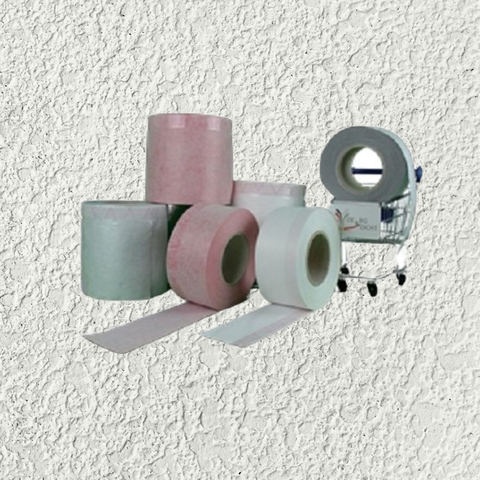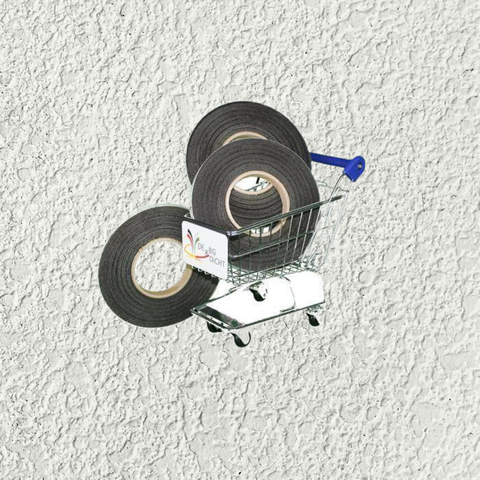Is Kompriband suitable for plastering over?
Are you renovating your home and want to seal the joints between the brickwork properly? Compriband could be the solution, but is it also suitable for plastering over? This article will tell you everything you need to know about using Kompriband for façade design.
Compriband is a versatile sealing material that can be used in various areas to seal leaks. It is made of expanded polyurethane, which expands during installation to ensure a permanent seal. But is it also suitable for plastering over?
That depends on various factors, such as the type of plaster and the quality of the Kompriband. Some Compribands are more suitable for plastering over than others. In this article, we will explore the different types of Kompriband and help you make the right choice for your façade design.
Learn how to properly prepare and apply Kompriband for over-plastering to achieve an optimal result. Also discover alternative waterproofing methods if Kompriband is not the best solution for your project.
Read on to find out more about the use of Kompriband for over-plastering and let your façade shine in new splendour.
What is Kompriband and what is it used for?
Kompriband is an elastic sealing material made of expanded polyurethane. It is mainly used to seal joints and cracks that can occur between different building components. The special property of Kompriband is its ability to expand during installation and thus ensure a permanent seal. This material property makes it particularly suitable for use in construction projects where a reliable and flexible seal is required.
The use of Kompriband ranges from sealing windows and doors to joints between masonry and plaster. It can be used at different stages of construction to ensure that the structural integrity of the building is maintained. Kompriband's ease of use and effective sealing performance have made it a favourite material with many construction professionals.
In addition, Kompriband is available in various widths and thicknesses, making it adaptable for different applications. It can be used in new builds as well as renovation work and offers a cost-effective solution to sealing problems. The versatility and efficiency of Kompriband make it an indispensable tool in the modern construction industry.
Advantages of using Kompriband for plastering over
The use of Kompriband for plastering over offers numerous advantages that increase both the quality and durability of the waterproofing. One major advantage is the flexibility of the material. Kompriband can expand and contract with the movement of the building elements, making it ideal for applications that are subject to constant stress. This flexibility helps to prevent cracks and leaks that often occur with conventional sealing methods.
Another advantage of Kompriband is its ease of use. It is easy to cut and customise, making installation quick and straightforward. This ease of use saves time and labour costs, which is crucial for many construction projects. In addition, the application of Kompriband requires no special tools or techniques, making it accessible to DIY enthusiasts.
Furthermore, Kompriband is extremely durable. It is resistant to weathering, UV rays and chemical influences, which means that it retains its sealing ability even under extreme conditions. This leads to a longer service life for the façade and reduces the need for frequent maintenance or repairs. The combination of these benefits makes Kompriband an excellent choice for over-plastering and general waterproofing of buildings.
Types of Compriband for plastering over
There are different types of Kompriband, each suitable for specific applications. The most common forms are self-adhesive Kompriband, which allows for easy installation, and non-adhesive Kompriband, which is often used for more professional applications. Self-adhesive Compriband can be applied directly to clean and dry surfaces, which greatly simplifies and speeds up installation.
Another distinction concerns the density and width of the Compriband. Depending on the application, a thicker or thinner tape may be required. Thicker tapes are more suitable for larger joints, while thinner tapes are ideal for smaller cracks. It is important to select the correct thickness and width to ensure that the Kompriband provides the required sealing performance.
In addition, there are special variants of Kompriband that have been developed for special requirements, such as e.g. . fire protection or soundproofing properties. These special products offer even greater safety and efficiency in sensitive areas. When choosing the right Kompriband for plastering over, it is crucial to consider the specific requirements of the project.
Areas of application of Kompriband for plastering over
The areas of application for Kompriband are diverse and extend beyond the simple sealing of joints in the façade. One common area of application is the sealing of transitions between different building materials, such as between masonry and plaster. Here, the Kompriband ensures that no moisture can penetrate and that the structure of the building remains protected in the long term.
Another important area of application is the refurbishment and renovation of old buildings. Old joints and cracks are often worn or damaged, resulting in inadequate sealing. By using Kompriband, these problems can be rectified quickly and effectively without the need for extensive building work. This is particularly valuable when it comes to improving the energy efficiency of a building and reducing energy consumption.
Kompriband is also used indoors, for example when sealing joints between walls and ceilings or when installing drywall. Here it helps to improve the indoor climate by minimising air leaks and thus reducing heat loss. The versatility of Kompriband makes it an indispensable material in numerous construction and renovation projects.
Tips for selecting and installing Compriband for plastering over
When selecting Kompriband for plastering over, it is important to pay attention to the specific requirements of the project. Firstly, you should determine the type of joints and their width. Depending on the size of the joints, you may need a different thickness of Compriband to ensure optimum sealing. It is advisable to compare different products and check the technical specification to make the best choice.
Another important aspect is substrate preparation. Before applying Kompriband, the surfaces must be clean, dry and free of dust and grease. Thorough cleaning of the substrate ensures that the Kompriband adheres optimally and its sealing performance is not impaired. In many cases, it can be helpful to treat the substrate with a primer to further improve adhesion.
When installing Kompriband, it is advisable to follow the manufacturer's instructions exactly. This includes both the correct application temperature and the recommended expansion rate. Take care to stretch the Kompriband evenly and avoid creating wrinkles, as this can impair the sealing ability. Careful application is crucial to the long-term success and effectiveness of the seal.
Important properties of Kompriband for plastering over
The important properties of Kompriband that make it suitable for plastering over are numerous. One of the most outstanding properties is the high elasticity of the material. Kompriband can expand and contract again under pressure or load without cracking. These elastic properties are crucial for maintaining the seal even with changing building structures.
Another significant advantage is its resistance to weathering. Kompriband is resistant to UV radiation, rain and extreme temperatures, making it an ideal choice for outdoor applications. The material is also unaffected by the chemical influences that often occur in urban environments. This contributes to the durability and reliability of the seal, which is particularly important for the long-term preservation of the building structure.
Kompriband is also characterised by excellent adhesion to various materials, including concrete, masonry and plaster. This versatility allows for a wide range of applications and ensures that Kompriband can be used effectively in a variety of construction projects. The combination of these properties makes Kompriband a first-class material for sealing when plastering over.
Differences between Kompriband and other sealing materials
Kompriband differs from other sealing materials, such as silicone, acrylic or sealant, in several key aspects. While silicone and acrylic often have a rigid structure, Kompriband offers the necessary flexibility to adapt to movements of the building. This flexibility is crucial to avoid cracks and leaks that often occur with rigid materials.
Another difference lies in the installation. Kompriband can be installed quickly and without additional tools, whereas other waterproofing materials often require extensive pre-treatment and special tools. This makes Kompriband a more user-friendly solution, especially for DIY enthusiasts who may not have the necessary expertise or equipment to apply other materials correctly.
In addition, Kompriband is often more environmentally friendly as it generally does not contain harmful chemicals found in many conventional sealants. This helps to improve indoor air quality and is particularly important for construction projects where occupant health is a priority. The differences between Kompriband and other waterproofing materials make it a preferred choice for many construction and renovation projects.
Frequently asked questions about Kompriband for plastering over
A common question when using Kompriband for plastering over is whether it is suitable for all types of plaster. The answer is that the suitability of Kompriband for plastering over depends heavily on the type of plaster and the nature of the substrate. In general, however, Kompriband can be used with most types of plaster as long as the correct preparation and application are observed.
Another common question concerns the service life of Kompriband. As a rule, Kompriband can last for many years, provided it is installed and used under the right conditions. However, the actual service life depends on various factors, such as weathering, UV exposure and mechanical stress. However, with proper care and maintenance, Kompriband can fulfil its function over a long period of time.
Another point that is often raised is the question of the cost-benefit ratio. Compriband may be slightly more expensive to purchase than conventional sealants, but in practice it has been shown that the long-term savings from less maintenance and a longer service life justify the initial investment. Kompriband is therefore an economically sensible choice for many construction projects.
Conclusion
To summarise, Kompriband is an excellent solution for waterproofing and plastering over buildings. The advantages it offers, such as flexibility, easy handling and excellent durability, make it a favoured material in the construction industry. Whether for new builds or renovation projects - the application options are diverse and the results are impressive in terms of quality and durability.
When selecting and installing Kompriband, a number of important aspects should be taken into account in order to achieve optimum results. Proper preparation of the substrate, selection of the appropriate product and careful application are crucial to the success of the project. The differences between Kompriband and other waterproofing materials also highlight the benefits and the need to consider Kompriband as the preferred solution.
Ultimately, Kompriband is not only a practical choice, but also an economically sound investment in the longevity and safety of your construction project. Whether you are an experienced building professional or a DIY enthusiast, using Kompriband will help you to solve your waterproofing problems efficiently and sustainably.




_400x400.webp?ts=1735165250)




